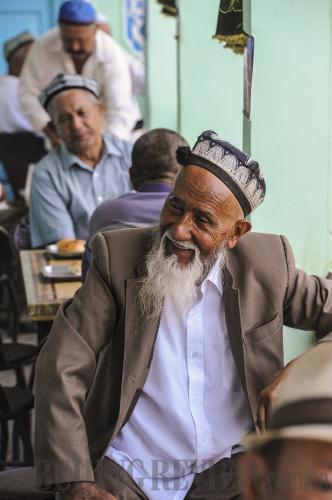|
 |
|
LEISURE TIME: Locals enjoy their tea time in an old teahouse in ancient Kashgar (SHEN QIAO) |
Called "the best-preserved example of a traditional Islamic city to be found anywhere in central Asia" by American architect and historian George Michell, the old city of Kashgar is a vital cultural intersection on the historic Silk Road in the remote west of China's Xinjiang Uygur Autonomous Region.
Michell made this observation in his 2008 book Kashgar: Oasis City on China's Old Silk Road. Before him, German-Swiss film director Marc Forster made similar remarks concerning his decision to film Kite Runner (2007) in Kashgar instead of Afghanistan, where the story was set.
Sand-colored houses, women dressed in various kinds of hijab, and men in robes and skullcaps—all of this makes Kashgar stand out compared with many other places in China. More than 95 percent of Kashgar's residents are of non-Han ethnicity, whereas people of other ethnicities comprise less than half of the population in the regional capital of Urumqi. Thus it is said that without traveling to Kashgar, you cannot say you have really been to Xinjiang.
Much of the architecture in the old city remains as it was 2,000 years ago when Uygur people settled in Kashgar. More than 126,800 people call the 4.25-square-km area home.
Long old life
Skyscrapers and old houses see each other over just one street in Kashgar. A ferris wheel of an amusement park opposite to the old city demarcates an apparent boundary, but the screams of parkgoers riding rollercoasters drift into the old town from time to time.
Kashgar's old city can be divided into two parts—one, packed with workshops, vendors, cafes and restaurants, has been tidily renovated. New developments with Uygur characteristics have emerged since 2009, and bazaars have been reorganized according to types of wares: hats, food and musical instruments, to name but a few categories.
The residential buildings are as they were, built in higher locations and normally two or three stories tall and built of mud and wood, with beautifully carved ceilings. The original support structures have remained unchanged for centuries, and many houses have been passed down through seven or eight generations.
Each house has a courtyard, some big and some small. Similarly, all the yards feature trees and flowers favored by Muslims, such as mulberry, fig, pomegranate, almond, grape and roses. The yards are heavily shaded, providing a tranquil environment for relaxation. Larger yards feature pergolas for grape vines.
| 